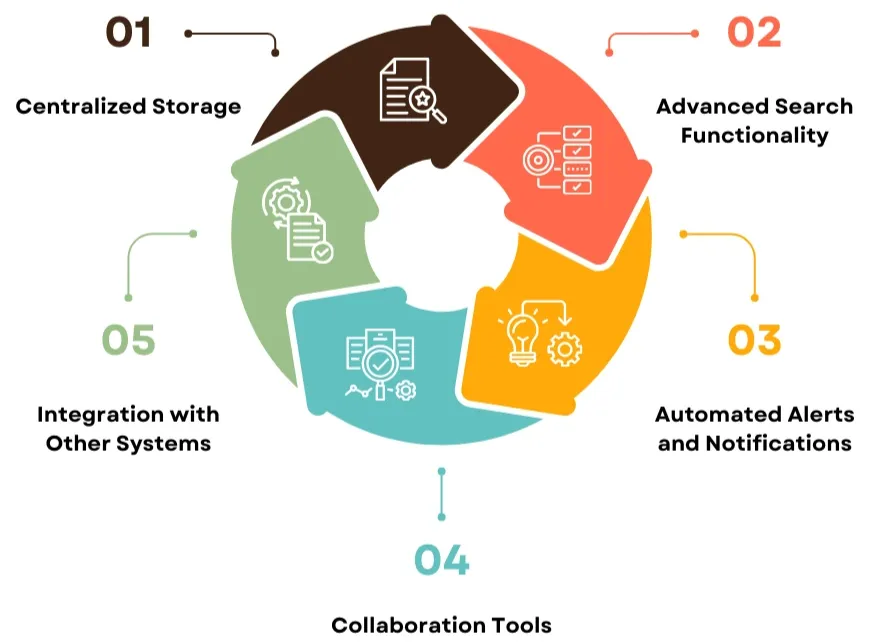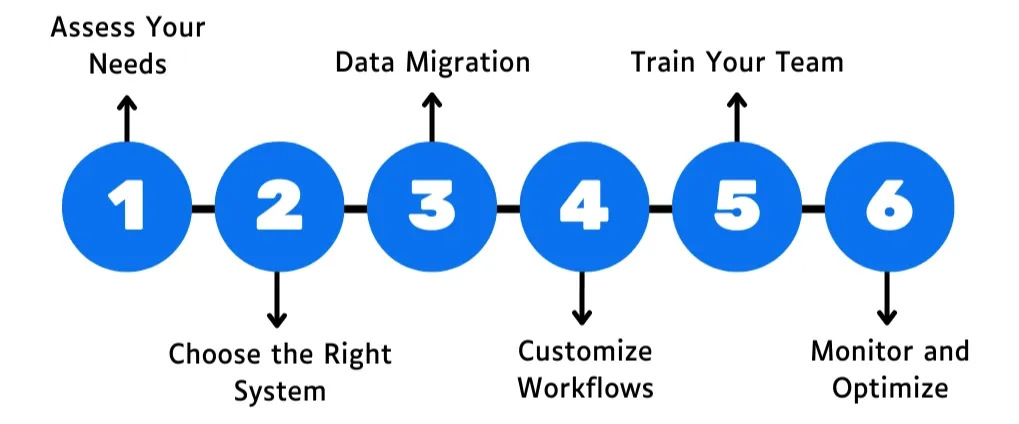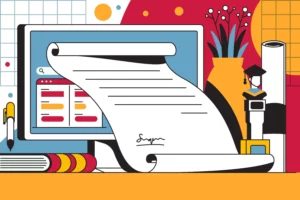Effective contract management is crucial for mitigating risks, ensuring compliance, and driving success. Yet many organizations still rely on outdated methods like physical filing cabinets, spreadsheets, or email for tracking contracts. This makes managing sensitive data challenging and can lead to legal or financial issues. A contract repository system acts as a single source of truth, providing a central hub for storing and managing all contracts securely. With a centralized repository and advanced data extraction features, companies can streamline the entire contract lifecycle, ensuring efficient and organized contract management.
What is a Contract Repository?
A contract repository is a safe and organized place for businesses to keep their contract information. It is a better choice than old ways, like filing cabinets or shared drives. A contract repository holds all related documents and messages in one spot. This includes original contracts, changes, addendums, and different versions. Everyone can easily get the latest information.
Having a contract repository has a great benefit. It includes a version control feature. This feature keeps track of all the changes made to a contract over time. It helps to prevent confusion and ensures everything is accurate. In addition, it provides a clear audit trail. This is important for following rules and solving any disputes.
Definition and Purpose of Contract Repositories
A contract repository is a system made to store and manage contracts in digital form. It acts as a central place where approved people in an organization can find these documents. This setup keeps all contract documents safe and makes it easier to work with them. A contract repository is not just for storing contracts; it has more purposes.
It has features that support the entire contract lifecycle. This includes creation, negotiation, execution, tracking, and renewal. By bringing together all related information and communication, it makes things clearer. This allows people to work better together. A secure contract repository uses several methods to block unauthorized access and protect data integrity. Access control limits who can view and edit documents. Only authorized people can do this based on their roles. Data encryption keeps sensitive information safe when it is stored and sent. This greatly lowers the chance of data breaches or leaks.
Automation and Workflow Capabilities
Advanced contract repositories make it simple to manage contracts. They use automation and allow you to change workflows as you need. These systems save time by automating tasks like making contracts, getting approvals, and collecting signatures. This helps teams focus on more important work.
Workflow features help make a clear and organized contract lifecycle. They show simple steps and who needs to do each task. They also let you track how things are moving along. This increases transparency and helps people finish tasks on time.
Additional features include automatic renewals, managing deadlines, and access control based on roles. These features help lessen manual work, lower mistakes, and ensure we comply with rules.
You might want to read: What is a Contract Repository?
The Evolution from Excel to Advanced Contract Repository Systems
Managing contracts is important for businesses. It helps them follow the rules, reduce risks, and maintain good relationships with clients, vendors, and partners. Many companies used Excel to track and manage contracts before. This worked fine for smaller businesses. But as companies grew and contracts became more complex, Excel had its limits. Because of this, better options like contract repository systems became more popular.
The Early Days: Contract Management with Excel
For many businesses, Excel was the key tool for managing contracts. It was simple to use and very flexible. Users could quickly create spreadsheets to track contract details. They also kept up with deadlines, renewal dates, and terms easily. This method was a clear way to manage contract data without needing to spend a lot of money at first.
Advantages of Excel for Contract Management:
- Low cost: Excel often comes with business software packages, which helps save money.
- Familiarity: Many workers know how to use Excel, so they don’t need much training.
- Customizable: Excel is very flexible, allowing businesses to modify spreadsheets to meet their needs.
The Shift to Advanced Contract Repository Systems
As companies realized that Excel had its limits, they looked for better choices. This led to the rise of contract repository systems. These tools are designed specifically to manage contracts from beginning to end. They help organize, track, and securely store contracts all in one location.
The Limitations of Excel in Modern Contract Management
Excel is a common tool for simple contract tracking. But as contract management becomes more complex, it has some drawbacks. Here are the main issues with using Excel for contract management today:
- Manual Data Entry & Errors: Using Excel means you have to update data by hand. This increases the chances of making mistakes. Errors in data entry can lead to missing contracts, deadlines, and tracking problems.
- Lack of Automation: Excel does not have automatic reminders or workflows for important dates like contract renewals or compliance checks. This makes it easy to miss important deadlines.
- No Version Control: When several users work together, it’s hard to keep track of the latest versions of contracts. This can cause confusion, mix-ups, or even legal problems with old terms.
- Limited Collaboration: Excel does not support teamwork in real time. When many team members need access to the same file, it’s difficult to keep the information accurate and updated.
- Security Concerns: Storing sensitive contract data in Excel lacks enough security features for today’s needs. Shared files can be easily accessed by people who shouldn’t be able to see them.
Key Features of a Contract Repository System

When choosing a contract repository system, you should know the important features that are good for contract management. Here are the key features to have:
1. Centralized Storage
A contract repository system keeps all your contracts and related documents in one secure spot. You won’t need to search through emails, shared drives, or filing cabinets anymore. Instead, you can get instant access to every contract your organization has.
2. Advanced Search Functionality
Contract repository systems are better than doing things by hand. They have smart search features. You can find contracts by using keywords, names of parties, contract details, or special clauses. This is very helpful when you have to manage a lot of contracts. It saves time and reduces the risk of making errors.
3. Automated Alerts and Notifications
Missing key deadlines, such as contract renewals, compliance requirements, or payment dates, can lead to expensive fines. A reliable contract storage system offers automatic alerts and reminders for essential dates. This way, you can handle every contract task smoothly.
4. Collaboration Tools
In today’s online work setting, teamwork is key. A contract repository system allows many users to open and edit contracts simultaneously. Features such as commenting on documents, handling workflows, and automatic approval routing make it easier for teams to work together smoothly.
5. Integration with Other Systems
Most contract repository systems can connect with other software. This includes tools like Customer Relationship Management (CRM) systems, Enterprise Resource Planning (ERP), and e-signature platforms. When these systems work together, information flows smoothly between departments. This helps to automate many tasks. As a result, it reduces the amount of administrative work needed.
You might want to read: What is a Contract Repository?
Traditional Contract Repository vs. Modern Contract Repository
|
Feature |
Traditional Contract Repository |
Modern Contract Repository |
|
Storage |
Physical files, Excel sheets, or shared drives |
Cloud-based, centralized digital storage |
|
Access |
Limited access, often location-dependent |
Remote access from any device with role-based permissions |
|
Search Capabilities |
Manual search through files or documents |
Advanced search with filters (by contract type, dates, etc.) |
|
Collaboration |
Difficult, version control issues with multiple users |
Real-time collaboration, version control, and tracking |
|
Security |
Basic, often reliant on physical security or file passwords |
Advanced encryption, role-based access, and audit trails |
|
Automation |
None; manual tracking of deadlines and renewals |
Automated reminders for key dates, approvals, and compliance checks |
|
Scalability |
Difficult to scale as contract volume grows |
Easily scalable to handle large volumes and complex contracts |
Implementing a Contract Repository System: A Step-by-Step Guide

Implementing a contract repository system can simplify contract management and improve efficiency. Here is an easy guide to help you get started:
- Assess Your Needs: Look at what is wrong in your contract management process. This could be missed deadlines, compliance problems, or teamwork issues. Knowing these helps you choose the right system.
- Choose the Right System: Look for features like a central storage area, automatic alerts, version control, and connections to tools you already use, like CRM or ERP systems. Make sure the system can grow with your needs and offers good security.
- Data Migration: Gather all your current contracts from spreadsheets, shared drives, or physical files. Clean and organize this data before moving it to the new system to keep everything accurate.
- Customize Workflows: Set up automated workflows for tasks. This includes getting approvals, sending renewal reminders, and checks for compliance. Adjust alerts and access rules to match the roles in your organization.
- Train Your Team: Provide full training to your team. Make sure everyone knows how to use the new system effectively. Explain the benefits clearly to encourage use.
- Monitor and Optimize: After setting up the system, watch how well it works. Use reports and analytics to find ways to improve and make changes to enhance the workflow.
By following these steps, you can easily change to a contract repository system. This change will help you improve your contract management process.
Benefits of Using a Contract Repository System
Implementing a contract repository system can be very helpful for organizations. It can increase efficiency, reduce risks, and enhance compliance. Here are the main benefits:
1. Improved Contract Visibility
A centralized contract repository keeps all contract activities in one place. This means everyone can see the most up-to-date information. With this clear view, there is less chance of miscommunication. It also allows teams to decide faster and make better choices.
2. Reduced Legal and Financial Risks
A contract repository system lowers legal and financial risks. It does this by automating key tasks. These tasks involve tracking contracts, sending reminders for renewals, and checking for compliance. Organizations can avoid penalties from missed deadlines. They can also ensure contracts are reviewed and approved correctly. This system helps them follow regulatory requirements.
3. Increased Efficiency
Manual contract management takes a lot of time and can cause errors. A contract repository system helps by automating common tasks. It can handle stuff like contract approval workflows and reporting. This allows legal and procurement teams to spend more time on important work. They can negotiate better terms and manage relationships more effectively.
5. Cost Savings
A contract repository system can help businesses save money. It does this by automating tasks for managing contracts. This system reduces mistakes made by people and helps ensure deadlines are met. It also protects businesses from expensive legal issues and fines that come from not following rules.
6. Scalability
As your business gets bigger, you’ll have more contracts to manage. A contract repository system can grow along with you. It can manage thousands of contracts, making it a smart choice for companies that are expanding.
How to Choose the Right Contract Repository System

Choosing the right contract repository system for your organization is key. Here are some things to consider when exploring your options:
1. User-Friendly Interface
The system should be simple and easy to use. This allows users to manage contracts without needing a lot of training. If the system is too complicated, it may create problems and make it hard for people to begin using it.
2. Customization Options
Find a system that can change to fit your organization. It should work well with your workflows, types of contracts, and approval steps. Being able to customize fields, reports, and alerts will help the system serve your needs better.
3. Integration Capabilities
Make sure the contract repository system works with your tools like CRM, ERP, and e-signature platforms. This will make it easy to share data and help automate work in different departments.
5. Customer Support
Reliable customer support is very important. This is especially true when you begin using a new system. You need to choose a provider that offers complete support services. This should include training, help for any problems, and regular updates.
6. Cost
Think about how much money you will spend in total. This means setup fees, subscription costs, and any extra costs for more features or users. Look at the long-term return on investment (ROI) by seeing how much time you save. Also, think about the risks that are lower and the rules that are followed because of the system.
You might want to read: How to Review Contracts More Quickly and Effectively?
Managing a Contract Repository with CLM
Contract Lifecycle Management (CLM) systems assist you in handling contracts. They make the entire process simpler and more organized. Here’s how you can improve your contract storage using CLM:
- Centralized Storage: Keep all your contracts in one place. A centralized contract repository system is a safe and easy way to store contracts. This helps reduce the risk of losing or misplacing important documents.
- Automate Processes: Set up automation for making contracts, getting approvals, renewals, and sending notifications. This reduces manual work and lowers compliance risks. You can connect it with digital repositories like Google Drive or Microsoft Word for smoother workflows.
- Track and Monitor: Use the tracking tools in CLM. These tools include optical character recognition and artificial intelligence. They help you monitor contract statuses, key contract dates, and compliance. This way, you can better manage your contractual obligations and avoid missing deadlines.
- Manage Workflows: Create and automate workflows for reviewing, approving, and signing contracts. This helps make the whole process smoother and manage your entire contract portfolio more effectively.
- Analyze Data: Use CLM’s reporting and analytics tools. They give you useful insights into contract performance and contract value. This leads to better decisions related to contractual data.
- Integrate Systems: Connect CLM with other systems in your tech stack. This will allow for an easy flow of data. It makes handling legacy contracts and current contract metadata simpler.
How Volody’s contract repository helps you manage contracts efficiently?
Volody’s AI-powered Contract Management Software makes it easy to handle contracts. It helps you from the beginning to the end of a contract. With smart AI and machine learning, it simplifies writing, checking, approving, and tracking. It also ensures everything follows the rules, which helps prevent errors. Volody’s tool is easy to use. It improves your work, reduces manual tasks, and speeds up the contract lifecycle.
- Smart Search Function: Find old contracts quickly with OCR. You can search by type, counter-party, obligations, or clauses. This keeps a clear version history and audit trails.
- Metadata Extraction: Use AI to automatically extract and check metadata from old contracts. Make reports with key information to improve business knowledge.
- Legacy Contracts: Transform old contracts into a digital format. Use advanced OCR and NLP for this. It helps automate metadata extraction and sends reminders for renewals.
Conclusion
Using a modern contract repository system is key for better business operations. It makes managing contracts safer and simpler. When companies switch from Excel to a better system, they save time and money. This change also boosts security and helps them work more efficiently.
The important thing is to pick a solution with strong automation and solid security. It should handle different kinds of documents too. New technologies, like AI and machine learning, can make contract management smarter and more efficient. To keep up, consider using a good contract repository system that suits your business needs.
FAQs
What is the difference between contract management and a contract repository?
Contract management covers all steps in the contract lifecycle. It begins with creating the contract. Then, it moves on to execution and continues afterward. A contract repository is a system that stores and organizes contract details. It helps manage contracts well by putting all contract data in one place. It also keeps track of obligations. This allows for easy access to information. With this, making better decisions becomes simpler.
How does a contract repository enhance data security?
A contract repository keeps sensitive information secure by storing it in one place. Access control methods, like role-based permissions and data encryption, make sure that only the right people can view certain data points. It also tracks all actions taken, which helps reduce the risk of data breaches or leaks.
Can small businesses benefit from investing in a contract repository system?
Small businesses can really gain from a contract repository system. It keeps contracts well-organized and makes work easier. This system also encourages teamwork among business teams and provides strong security. Easy access to contract information helps in making quick and better decisions.
How does a contract repository improve contract visibility and tracking?
A contract repository improves visibility by centralizing all contracts in one system, making it easier to search, sort, and track key details. Automated reminders and notifications can be set for important dates, such as renewals or deadlines, ensuring no obligations are missed. This streamlined access and tracking allow teams to stay on top of contract obligations and make informed decisions more efficiently.





